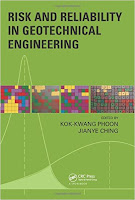Probabilistic Methods in Geotechnical Engineering
D. V. Griffiths, G. A. Fenton ... 346 pages - Publisher: Springer; (June, 2010) ... Language: English - ISBN-10: 3211733655 - ISBN-13: 978-3211733653.
Learn to use probabilistic techniques to solve problems in geotechnical engineering. The book reviews the statistical theories needed to develop the methodologies and interpret the results. Next, the authors explore probabilistic methods of analysis, such as the first order second moment method, the point estimate method, and random set theory. Examples and case histories guide you step by step in applying the techniques to particular problems.
Learn to use probabilistic techniques to solve problems in geotechnical engineering. The book reviews the statistical theories needed to develop the methodologies and interpret the results. Next, the authors explore probabilistic methods of analysis, such as the first order second moment method, the point estimate method, and random set theory. Examples and case histories guide you step by step in applying the techniques to particular problems.











